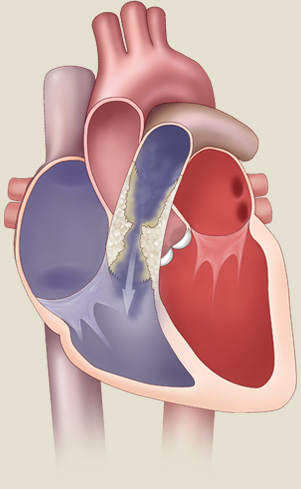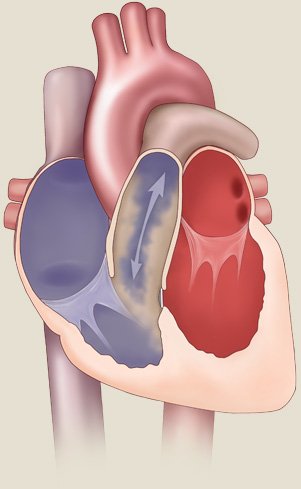TPVR Could Help Delay the Need For Your Next Open-Heart Surgery
TPVR Could Help Delay the Need
For Your Next Open-Heart Surgery
Talk to your doctor if you experience any of these symptoms.
Sometimes after the initial treatment for your congenital heart disease, you may need additional surgeries throughout your life to treat your heart-related health problems. Having a less invasive option for patients can be life changing.
If you were born with CHD that required surgery to temporarily repair your pulmonary valve or RVOT, your previous procedures that repaired your heart may begin to fail leading to either stenosis (narrowing of the valve or area around it) and/or regurgitation (leaking of the valve or valve area).

Pulmonary stenosis (narrowing) occurs when calcium forms on the native pulmonary valve, surgically placed bioprosthetic valve or in the RVOT. The narrowing will not allow blood to flow at a normal rate causing the heart to pump harder. Those with severe pulmonary stenosis will need to treat the pulmonary valve so blood can flow properly through the body.
People with pulmonary stenosis should see their doctor regularly to make sure the narrowing isn't getting worse.

Pulmonary regurgitation (PR) occurs when the valve does not close all the way, and blood leaks backwards from your pulmonary valve into your heart, instead of flowing into the lungs. Your heart must work harder than usual to pump this blood out. If your pulmonary valve has minimal leakage, you may have little to no symptoms. As the regurgitation becomes worse, it may cause you to experience symptoms or make your symptoms worse. If this happens, your doctor may recommend your pulmonary valve be replaced.
It is very important that adults with this condition are monitored by a cardiologist regularly.
If your pulmonary valve is failing your doctor may tell you that a procedure is needed to restore your valve’s function to help with blood flow. Depending on your medical history and what your current diagnosis is, will determine what your doctor will suggest as a treatment option.

During this minimally invasive procedure, a catheter holding the new pulmonary valve is inserted through a vein in your leg and guided your heart. Once the valve is in the correct spot, your doctor will expand the new pulmonary valve into place using a balloon.

During open-heart surgery, the doctor will open the chest, remove the failing pulmonary valve, and sew in a bioprosthetic pulmonary valve. For those with CHD, your doctor will need to evaluate how many open-heart surgeries you heart can handle.

When the valve is narrowed, the leaflets may become thick or stiff, or fused together. During this procedure, your doctor will insert a balloon catheter into the pulmonary valve to make the opening larger. It helps the blood flow more easily.

During this procedure, your doctor makes an incision in the pulmonary valve to enlarge the pulmonary valve. It allows blood to flow more easily into the pulmonary artery.
If you are seeing your doctor regularly, they will be monitoring your heart and will be able to tell you when treatment is necessary. The decision of when to get your valve replaced is unique and individualized for each person. This can be very scary and uncertain time but staying in contact with your doctor is the most important advice when it comes to the health of your heart.

TPVR Could Help Delay the Need For Your Next Open-Heart Surgery
TPVR Could Help Delay the Need
For Your Next Open-Heart Surgery
Talk to your doctor if you experience any of these symptoms.
TPVR provides a less invasive treatment option for people who typically face the burden of multiple open-heart surgeries, often beginning at birth. As surgical risk increases with each open-heart surgery, minimally invasive options can help patients recover and return to normal activities sooner.
Only a doctor trained in this procedure can tell if TPVR is right for you.
Find a DoctorIf you had your pulmonary valve or the area surrounding the valve previously treated and now they have either become narrowed (which is called stenosis) or leaky (which is called regurgitation) your doctor may decide that pulmonary valve replacement is necessary. TPVR is a less invasive option for those who need a new pulmonary heart valve.
The Edwards SAPIEN 3 Valve with the Alterra
The Edwards SAPIEN 3
Valve with the Alterra
Adaptive Prestent

Want To Stay Informed About the Latest Pulmonary Therapies?
Want To Stay Informed About the
Latest Pulmonary Therapies?